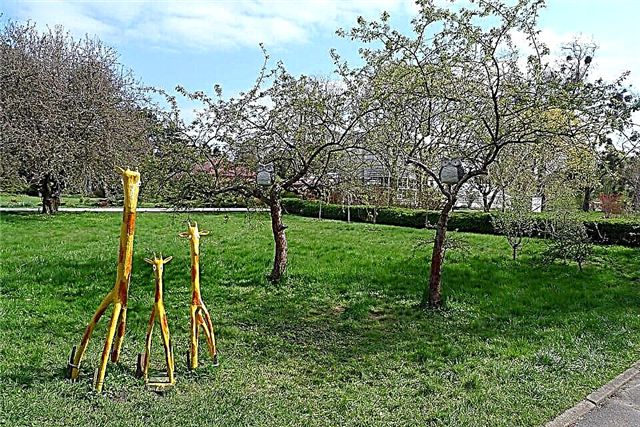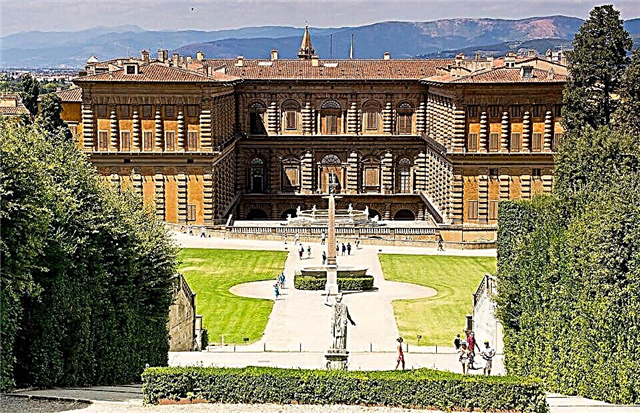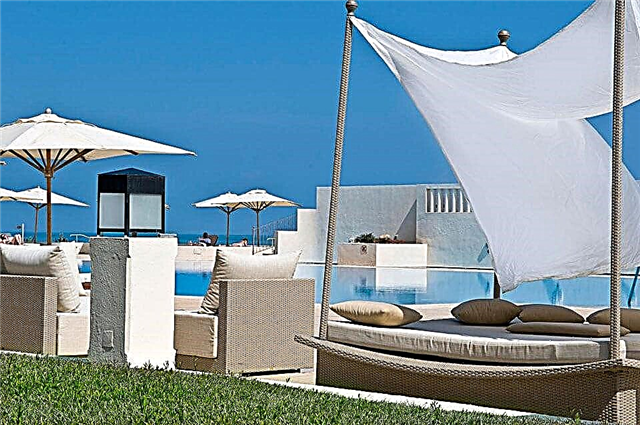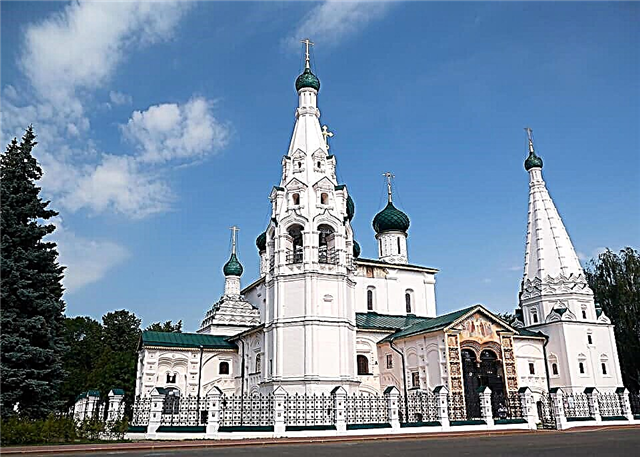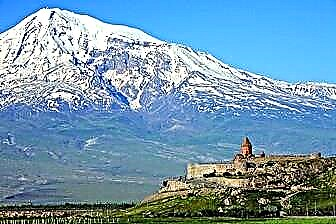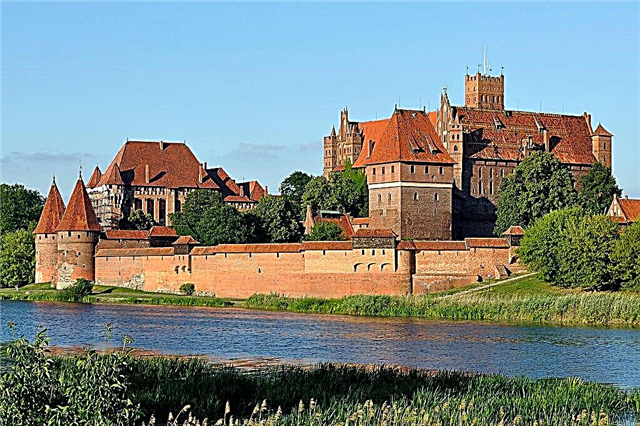Poland is a country with a rich history. Lovers of antiquity have something to see. To view architectural monuments, it is enough to visit the historical centers of the country's ancient cities. For example, Gdansk, Krakow or Torun, which have preserved historical buildings with a thousand-year history.
Many excursion routes include the castles - Marienburg, Wawel and Wilanow Palace. Museums will tell about the sad pages of Poland's history: Auschwitz-Birkenau, European Solidarity Center, Museum of the Second World War. Separately, it is worth mentioning religious buildings. These are large architectural complexes - Kalwaria-Zebrzydowska. And some architectural masterpieces - Yasnaya Gora Monastery or Vang Church.

The best hotels and hotels at affordable prices.
from 500 rubles / day
What to see and where to go in Poland?
The most interesting and beautiful places to visit, photos and a short description.
Marienburg castle
In 1274 the castle was founded by the Teutonic knights. It was rebuilt and expanded several times in the XIV century. From the 15th to the 18th century it was the seat of Polish kings. The invasion of the Swedes, and then the Second World War, left only ruins from the castle. By now, the reconstruction initiated by the Polish authorities has been fully completed. Tourists can admire the castle as a magnificent example of Gothic brick art.

Warsaw Old Town
Historical district of Warsaw, founded in the 12th century. It is a popular tourist destination. After the Second World War, most of the buildings of the Old Town were rebuilt from photographs and preserved drawings, for which they were included in the UNESCO list. The old preserved buildings are the Cathedral of St. John the Baptist and the Warsaw Barbican. The center of the old town is the Market Square. Now it houses many cafes, shops and souvenir shops.

Wieliczka Salt Mine
The development of the rock salt deposit in Wieliczka took seven centuries. During this time, 7 levels of underground corridors with a total length of 200 km appeared in it. The depth of the deposit is almost 200 meters. UNESCO has taken this unique industrial site under its protection. Excursion routes include a visit to the Chamber of Casemir the Great, the underground chapel of St. Anthony and Danilovich mine shaft of the 17th century.

Wawel (Krakow)
An architectural complex located on a hill in Krakow. Includes the Cathedral of St. Stanislav and Vaclav and the Royal Castle. For Poland, these structures are the same symbol as the Kremlin is for Russia. A massive castle in the Gothic style, a cathedral with high 20-meter towers, several small chapels and churches - they create a unique architectural ensemble that is visited by hundreds of tourists every day.

Kazimierz (Krakow)
Monument to the history of Poland, is included in the area of the Old Town of Krakow. Historically, it is the place of residence of Jews. The famous film "Schindler's List" about the Holocaust was filmed here. There are 7 synagogues in the Jewish quarter, which managed to survive during the Second World War, now they have been restored. Travelers note the coziness and special atmosphere in Kazimierz, different from the Old Town.

Market Square and Cloth Hall (Krakow)
The central trading place of Krakow is the Market Square, founded in 1257. Palaces, churches and old buildings are located on a 200-meter-long square. In the center of the square there is the Cloth Hall - an architectural monument. Wooden benches are located under the arches in the neo-Gothic style, the walls are decorated with decorative stucco. Next to the Cloth Hall is the Church of St. Wojciech, who is almost 1000 years old.

St. Mary's Church (Krakow)
The construction of the cathedral was completed in 1397. The three-nave basilica was built in the Gothic style. One tower of the church is crowned with a pointed spire, the other - with a helmet. The tallest tower is 82 meters. The interior inside the church is decorated with stained glass windows, as well as works of sculpture and painting. The main decoration is the altar, 13 meters high. It is carved from linden and combines Renaissance and Gothic elements.

Historic center of Gdansk
One of the oldest cities in Poland - it was founded in the X century. The city is an architectural complex of buildings built in the XIII-XVIII centuries. There are many museums in Gdansk - archaeological, painting, marine. A large number of historical monuments are concentrated in the Old Town. At the entrance to the historic center, there is the Golden Gate, behind which are located the most beautiful buildings in the city.

Church of St. Mary (Gdansk)
The construction of the church with a height of 105 meters lasted from the middle of the 14th century to the beginning of the 16th century. There is an observation deck on the bell tower with views of the historic city center. Inside there are magnificent works of art from the Middle Ages - a stone Pieta, an astronomical clock, an altar built at the beginning of the 16th century. Local residents consider it a miracle that the church was practically not damaged in a fire in 1945.

Old town Zamosc
In the 16th century, Zamosc was built by Italian craftsmen as a fortress city, but in the 19th century, instead of the fortress walls, picturesque gardens were arranged. The historic city center with Renaissance buildings is a UNESCO World Heritage Site. Beautiful buildings are skillfully integrated into a single architectural urban ensemble. Among the architectural monuments, the building of the City Hall, the Zamoyski Palace, and the Cathedral are distinguished.

Old Torun
The oldest part of the city of Torun is included in the UNESCO cultural heritage list. The construction of the city began in the 13th century. The city walls have been partially preserved to this day, separating the historical part of the city from later buildings. The castle of the Teutonic Order, the Church of St. Mary and the House of Copernicus are considered masterpieces of brick Gothic. The center of the old district is the Old Market with the Torun Town Hall.

Wroclaw Town Hall and Market Square
The Market Square, founded in the 12th century, is the main attraction of Wroclaw. In different eras, it was built up with buildings of different architectural styles. In the center of the square there is a whole block of mansions with elements of Gothic and Art Nouveau in design. The most interesting object is the city hall. It took almost 300 years to build, from the 13th to the 16th century. Now the town hall is a museum object.

Wroclaw gnomes
Unusual bronze figurines of gnomes are the symbol of Wroclaw. It all started with the installation of a monument in the form of a gnome by the city authorities in 2001, and since 2006, many private organizations began to install their gnomes. Currently, there are about 400 figurines in different parts of the city. Each gnome has its own character and story. The quest to find all the dwarves of Wroclaw is popular among the guests of the city.

Hall of the Centenary and Wroclaw Fountain
The grandiose building, built in 1913, is used for concerts and sporting events. One of the world's first reinforced concrete structures, and at the same time it is a magnificent example of early modernism. Included in the list of objects protected by UNESCO. A multimedia musical fountain is installed next to the hall. Its illumination consists of 800 lighting points. In winter, a skating rink works at the site of the fountain.

Palace of Culture and Science (Warsaw)
Tallest building in the country. The height of the 42-storey skyscraper is 240 meters. The construction was carried out with the money of the Soviet Union by Soviet builders. The Moscow "Stalinist skyscrapers" were taken as a model. As a result, the palace building combines the styles of Stalinist neo-empire and Polish historicism. The premises of the building are occupied by museums and exhibitions, as well as offices of private organizations, shops, a swimming pool, theaters, conference rooms.

Manufaktura (Lodz)
Large shopping and entertainment center in the city of Lodz. It was built in a modernized building of a large 19th century manufactory. The area of the mall is 26 hectares. It houses more than 300 stores of major global and national brands. The complex also includes a hotel, a skate park, a bowling club, a rollerdrome, a climbing wall and a cinema with 15 halls. Notable is the fountain 300 meters long, installed near the mall.

Wilanow Palace
The palace was built at the beginning of the 17th century for King Jan Sobieski as a country residence. An architectural monument in the Polish Baroque style. It combines the principles of European art and the traditions of Polish building architecture. The facade is decorated with sculptures and intricate décor. In 1805, a museum was opened in the palace, which exists to the present day. The chic and picturesque Wilanow Park is laid out around the palace.

Warsaw Uprising Museum
The museum occupies 4 floors of the former tram depot building. Its exhibits are dedicated to the 1944 Warsaw Uprising. In total, 750 exhibits and about 1000 photographs are displayed at the museum's exhibitions. Near the museum, on the 156-meter-long Memorial Wall, the names of 10,000 dead insurgents are engraved. The movie "City of Ruins" is shown in the cinema hall, which shows the horror of the destruction and devastation of Warsaw during the uprising.

Auschwitz-Birkenau Museum (Auschwitz)
There were three large Nazi concentration camps in Auschwitz. During the Second World War, more than a million people died in them, mostly Jews by origin. In 1947, the Auschwitz-Birkenau Museum was opened here, dedicated to the terrible events of the war. More than a million people visit it every year. On the territory of the museum in 1967, a monument was opened in honor of the victims of Nazism.

Oskar Schindler's Factory (Krakow)
The activities of this factory are shown in the film "Schindler's List". The founder of the factory ransomed prisoners from concentration camps to work in production, so he helped thousands of people avoid death. The exhibition "Krakow during the Occupation 1939-1948" attracts a large number of visitors. It was opened in 2010 and tells about the history of the factory, the fate of the Jews of Krakow and the life of the population during the occupation.

European Solidarity Center (Gdansk)
Multimedia Museum and Library Complex in Gdansk. Opened in 2014 and is dedicated to the creation and operation of the Solidarity opposition movement. The building is made in the form of a ship, its area is 25,000 m². 6 halls of the museum tell about the emergence of the popular movement, the history of Poland, the change of the political regime and the fall of communism. Visitors can use the audio guide, including in Russian.

Museum of the Second World War (Gdansk)
Located on a peninsula in the city of Gdansk. The museum was opened in 2017. The building is an example of Polish modern architecture. The main exposition is located in the underground part. Its funds amount to 50,000 exhibits. The concept of the museum is interesting - to show the horrors of war not only from the point of view of politics, but through the eyes of an ordinary person. The installations of the museum are shocking and make a strong impression.

Wooden churches in the south of Lesser Poland
In the south of the country, there is a complex of valuable architectural wooden churches. They are created in different styles - Baroque, Renaissance, Gothic. The earliest objects were built in the XIV century. One of the first buildings is considered to be a church in Khachuv in 1388. Part of the complex is under the protection of UNESCO. A special tourist route has been developed to visit the southern Lesser Poland churches; it is popular among travelers.

Churches of the world
Large religious wooden buildings of the 17th century, included in the UNESCO list. Of the three built churches, two have survived to date. They are located in the towns of Swidnica and Javor. The church in Swidnica can accommodate 6,000 parishioners. Its ceilings are decorated with paintings of scenes from the Bible. The church in Javor, with an area of 1090 m², accommodates 7,500 parishioners. The architectural solutions of the facades of the churches are extremely original.

Kalwaria Zebrzydowska
A religious architectural and park complex in the center of Poland on the slopes of the mountains. During the construction of the park, the natural features of the area were taken into account. The structures of the park symbolize the procession of the cross and the passion of Christ. They have a complex architecture. The building of the chapel of the Cathedral of Our Lady is made in the form of a heart, the house of Pontius Pilate is in the form of a Greek cross, and the house of Kaifa is in the form of a simple ellipse.

Vang Church in Karpacz
Located at the foot of the Snezka Mountain in a beautiful dense forest. The church was built in the style of traditional Scandinavian architecture. The building was built in Norway in the XII century, and in the XIX century it was moved to Karpacz by order of the King of Prussia Wilhelm IV. The church was built from Norwegian pine without the use of nails, but at the same time it is an incredibly solid building. The facades of the outer walls are decorated with ornaments.

Monastery Clear Mountain (Czestochowa)
Catholic monastery in the city of Czestochowa. Belongs to the monks of the Pauline Order. They erected a monastery on a 293 meter high hill in the 14th century. The height of the bell tower of the monastery in the Baroque style is 106 meters. At the corners of the quadrangular monastery there are powerful arrow-shaped bastions. The main attraction is the Czestochowa Icon of the Mother of God, which is considered miraculous among believers.

Ksenzh Castle
It is located near the city of Walbrzych and is the third largest in Poland. The castle is part of the Piast Castles tourist route. Founded in the XIII century. It got its modern look under the possession of the Hochberg dynasty. During wartime, the Nazis removed all valuables from the castle. But even now there is something to see there. In a beautiful garden - an exhibition of flowers and shrubs, in the halls of the castle - an exhibition of porcelain and ceramics.

Zakopane
There are several ski resorts here. The city is called the "winter capital of the country" because of the thousands of tourists who visit Zakopane at this time of year. It is located at the foot of the Tatra Mountains. Clean air, beautiful views of snow-capped peaks, dense coniferous forest and well-developed infrastructure make it ideal for relaxation. Such entertainments as - tens of kilometers of ski tracks, skating rinks, thermal pools are presented.

Masurian lakes
A group of lakes with a total area of 310 km². Consists of 2000 reservoirs of different sizes of glacial origin. Picturesque forest reserves are located on the shores of the lakes. This place is popular with travelers not only for its natural beauty. The infrastructure for tourists is well developed here. It is possible to order a boat trip, a tour of historical sites, or just walk along the paths on the banks.

Tatra National Park
Large park in southern Poland. It is located in the landscapes of the Tart Mountains belonging to the Carpathians. Occupies an area of 22,000 hectares. 70% of the park's area is occupied by forests, the rest of the territory is covered by rocks with 750 caves, lakes and a waterfall. The forest in the park is predominantly coniferous. The highest mountain, Lynx, is popular with climbers. I like the park and hikers. Trails of varying difficulty have been laid for them with a total length of 270 km.

Belovezhskaya Pushcha
Large relict lowland forest. Included in the UNESCO heritage list. Located on the territory of two neighboring states - Poland and Belarus. The ancient forest is home to many animals, but the most valuable is the bison. Tourism is developed in the reserve on the Polish side. The main tourist center is the village of Bialowieza; it is here that tourists gather before excursion routes.

Wroclaw Zoo
The 33 hectare zoo was founded in 1865. At the same time, buildings were built in it of architectural value - the House of Monkeys or the House of Butterflies. The zoo is home to over 10,000 animals. An open-air cage with an area of 1.2 hectares has been built for brown bears. The pride of the zoo is Afrikarium - a large oceanarium with different ecosystems of the continent. Interesting sections are the Terrarium and the Madagascar Zone.

Lazienki Park (Warsaw)
An old palace and park complex with cultural and historical monuments. Founded in the 17th century by order of Hetman Lubomirsky. It houses the Palace on the Water - a secluded pavilion with a Chinese-style bath. Another attraction of the park is the Roman Theater. This is an amphitheater built by the water, decorated with statues of ancient poets. Undoubtedly, it is worth seeing the Old and New Greenhouses, the Myshlevitsky Palace, the White House.

Sopot beach and pier
The seaside resort of Sopot is famous for its sandy beach. Long, wide and safe. The necessary infrastructure has been equipped - changing cabins, sports grounds, cafes and bars. The length of the beach line is 4 km. There is also a historical landmark - a 55-meter-long wooden pier. Concerts are often held on its above-ground part, the "sea" part is ideal for walks.


